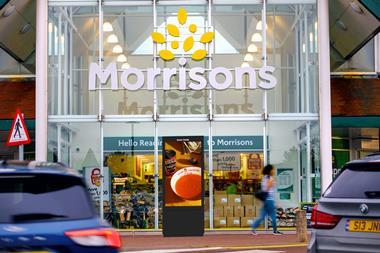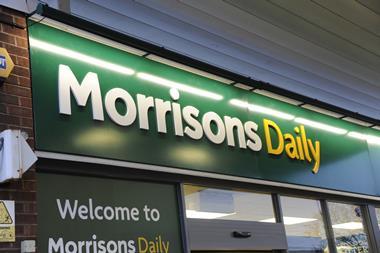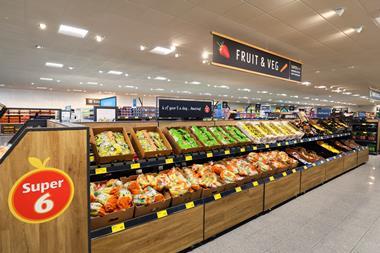Morrisons could be poised to dominate its first Scottish market by combining the opening of its first store north of the border with the acquisition of Safeway.
CACI’s analysis reveals that Morrisons’ Kilmarnock store will give the Bradford-based chain a 26% share of the store’s catchment, edging it ahead of Asda, which would hold a 21% local share.
When Morrisons acquires the many Safeway stores clustered in this western pocket of Scotland, then this local share could rise as high as 38%, giving it local dominance over Tesco, which would only serve 32% of the store’s catchment.
The large catchment of the Morrisons store reflects the size of the store, at 85,000 sq ft one of the company’s largest.
However, the store draws most strongly from the north of the catchment because of the light competition on this side of the town.
While a predicted turnover in the top 25% of the estate must be an encouragement to Morrisons, it is likely to need to work hard to drive sales from this large store.
CACI is predicting that the Kilmarnock store is likely to witness one of the lowest sales densities in the Morrisons estate, making this an expensive entry into the Scottish market.
Morrisons will be fighting for market share against just two of its usual key rivals in Kilmarnock. Sainsbury has no stores in the area from which to steal. However, the strong local presence of four Tesco stores and two Asda stores means that Morrisons must steal most of its new customers from the two leading retailers.
When Morrisons does secure Safeway, it is also likely to have to write-off a further £86,000 in lost sales because of cannibalisation from its new purpose-built store.
Considering that Morrisons has not ventured into Scotland before, its fascia has a remarkably strong fit with the Kilmarnock catchment.
Therefore, in spite of Morrisons’ known cynicism towards demographics, it appears to have chosen a site well and this store may perform above CACI’s base prediction. Morrisons is likely to be able to capitalise on its strong showing with the catchment’s dominant ACORN groups, the seemingly conflicting ‘Struggling families’ and ‘Secure families’.
However, Asda also performs well among these groups and overall has a fractionally better fit to the catchment.
Asda will, therefore, put up a good fight in an attempt to hold onto its customers.
However, Tesco has a much poorer demographic fit to the catchment, particularly among the ‘Struggling families’ and, therefore, may offer an easier target to steal customers from in order to help make these first steps into Scotland by Morrisons a success.
CACI’s analysis reveals that Morrisons’ Kilmarnock store will give the Bradford-based chain a 26% share of the store’s catchment, edging it ahead of Asda, which would hold a 21% local share.
When Morrisons acquires the many Safeway stores clustered in this western pocket of Scotland, then this local share could rise as high as 38%, giving it local dominance over Tesco, which would only serve 32% of the store’s catchment.
The large catchment of the Morrisons store reflects the size of the store, at 85,000 sq ft one of the company’s largest.
However, the store draws most strongly from the north of the catchment because of the light competition on this side of the town.
While a predicted turnover in the top 25% of the estate must be an encouragement to Morrisons, it is likely to need to work hard to drive sales from this large store.
CACI is predicting that the Kilmarnock store is likely to witness one of the lowest sales densities in the Morrisons estate, making this an expensive entry into the Scottish market.
Morrisons will be fighting for market share against just two of its usual key rivals in Kilmarnock. Sainsbury has no stores in the area from which to steal. However, the strong local presence of four Tesco stores and two Asda stores means that Morrisons must steal most of its new customers from the two leading retailers.
When Morrisons does secure Safeway, it is also likely to have to write-off a further £86,000 in lost sales because of cannibalisation from its new purpose-built store.
Considering that Morrisons has not ventured into Scotland before, its fascia has a remarkably strong fit with the Kilmarnock catchment.
Therefore, in spite of Morrisons’ known cynicism towards demographics, it appears to have chosen a site well and this store may perform above CACI’s base prediction. Morrisons is likely to be able to capitalise on its strong showing with the catchment’s dominant ACORN groups, the seemingly conflicting ‘Struggling families’ and ‘Secure families’.
However, Asda also performs well among these groups and overall has a fractionally better fit to the catchment.
Asda will, therefore, put up a good fight in an attempt to hold onto its customers.
However, Tesco has a much poorer demographic fit to the catchment, particularly among the ‘Struggling families’ and, therefore, may offer an easier target to steal customers from in order to help make these first steps into Scotland by Morrisons a success.


















No comments yet